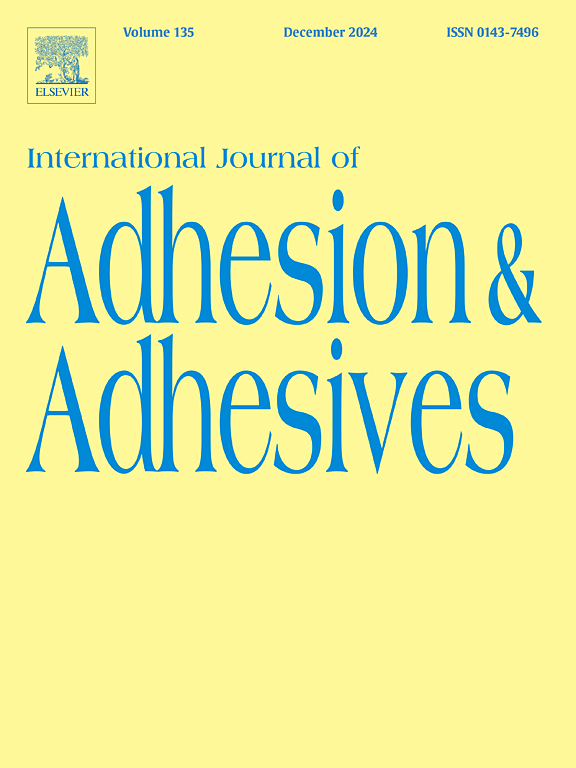Non-deterministic damage analysis of DCB bonded composite joints using a surrogate model
IF 3.5
3区 材料科学
Q2 ENGINEERING, CHEMICAL
International Journal of Adhesion and Adhesives
Pub Date : 2025-09-30
DOI:10.1016/j.ijadhadh.2025.104167
引用次数: 0
Abstract
Composite bonded joints are increasingly used in structural applications due to their high strength-to-weight ratio and design flexibility. However, understanding and predicting their fracture behaviour, especially in Mode I, is important for ensuring structural integrity and reliability. This study focuses on evaluating two-dimensional numerical models of the Double Cantilever Beam (DCB) manufactured of composite laminates. It builds upon previous experimental studies related to bonding while considering the manufacturing process and associated uncertainties, using the Finite Element Method (FEM). Deterministic analyses were carried out to assess the advantages and disadvantages of the models. Based on these assessments, a numerical model was selected to perform non-deterministic studies and apply metamodeling to estimate fracture strength of Mode I DCB bonded composite joints. This involved generating numerical models using Python® scripts linked with Abaqus® software. A Design of Experiments (DoE) strategy was developed to reduce the number of experiments while evaluating the effect of various design parameters. The design variable space was defined in terms of the geometrical characteristics of the specimen and their material properties, encompassing a total of 11 parameters. In other words, this evaluation aims to determine how much each variable influences the energy release rate . The Compliance-Based Beam Method (CBBM) was applied to determine the critical fracture energy in Mode I of the DCB bonded composite joint. From the DoE ranking, the five most influential variables were selected as design variables for the development of the surrogate model. It was noted that most of the variables exhibited epistemic uncertainty, particularly among the geometric variables. Subsequently, the training of the metamodel was conducted using Latin Hypercube Sampling (LHS) in conjunction with Efficient Global Optimization (EGO) defined by the optimized model. Overall, the proposed methodology effectively combines deterministic modelling, uncertainty quantification, and surrogate modelling to provide information into the fracture behaviour of bonded composite joints. The results indicate that the mechanical strength of the joint in Mode I, as predicted by the surrogate model, is strongly influenced by variables such as the energy release rate, adhesive and adherent thicknesses, fibre orientation, and initial crack length. Thus, this methodology helps the development of more robust design strategies for bonded composite structures subjected to out-of-plane stress components.
基于替代模型的DCB粘结复合材料接头非确定性损伤分析
复合材料粘结接头由于其高强度重量比和设计灵活性,在结构应用中得到越来越多的应用。然而,了解和预测它们的断裂行为,特别是在I模式下,对于确保结构的完整性和可靠性非常重要。本文研究了复合材料层合板双悬臂梁的二维数值模型。它建立在先前的实验研究的基础上,同时考虑到制造过程和相关的不确定性,使用有限元法(FEM)。进行了确定性分析,以评估模型的优缺点。基于这些评估,选择了一个数值模型进行非确定性研究,并应用元模型来估计I型DCB粘结复合材料接头的断裂强度。这涉及到使用Python®脚本与Abaqus®软件链接生成数值模型。提出了一种实验设计策略,以减少实验次数,同时评估各种设计参数的影响。根据试样的几何特征及其材料特性定义设计变量空间,共包含11个参数。换句话说,此评估旨在确定每个变量对能量释放率(GIc)的影响程度。采用基于柔度的梁法(CBBM)确定了DCB复合材料接头的I型临界断裂能。从DoE排名中,选择五个最具影响力的变量作为开发代理模型的设计变量。有人指出,大多数变量表现出认识上的不确定性,特别是在几何变量中。随后,使用拉丁超立方采样(LHS)结合优化模型定义的高效全局优化(EGO)对元模型进行训练。总体而言,所提出的方法有效地结合了确定性建模、不确定性量化和替代建模,为粘结复合材料接头的断裂行为提供信息。结果表明,与替代模型预测的一样,模式一接头的机械强度受到能量释放率、粘结剂和粘附剂厚度、纤维取向和初始裂纹长度等变量的强烈影响。因此,该方法有助于开发更稳健的设计策略,以适应面外应力构件的粘结复合材料结构。
本文章由计算机程序翻译,如有差异,请以英文原文为准。
求助全文
约1分钟内获得全文
求助全文
来源期刊

International Journal of Adhesion and Adhesives
工程技术-材料科学:综合
CiteScore
6.90
自引率
8.80%
发文量
200
审稿时长
8.3 months
期刊介绍:
The International Journal of Adhesion and Adhesives draws together the many aspects of the science and technology of adhesive materials, from fundamental research and development work to industrial applications. Subject areas covered include: interfacial interactions, surface chemistry, methods of testing, accumulation of test data on physical and mechanical properties, environmental effects, new adhesive materials, sealants, design of bonded joints, and manufacturing technology.
 求助内容:
求助内容: 应助结果提醒方式:
应助结果提醒方式:


